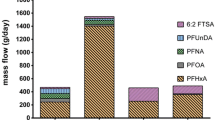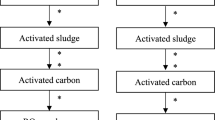Abstract
Our previous studies reported that perfluorooctanoic acid (PFOA) contamination decreased in well, tap, and surface water around a fluoropolymer plant in Osaka, Japan, between 2003 and 2016. In this study, we evaluated the degradability of PFOA and perfluorohexanoic acid in river soils to identify the influence of the degradation on the perfluorocarboxylic acids (PFCAs) in the Yodo River Basin. We also investigated the influence of abiotic oxidation on the formation of PFCAs in soils and measured the fluorotelomer alcohols (FTOHs) as precursors of PFCAs in the soil and air samples collected at Osaka and Kyoto. No major degradations were observed in soils contaminated with PFCA during the 24-week experimental period, while the PFOA levels increased only in the control group. The PFCA levels significantly increased after oxidation in this group. The dominant FTOH in soils was 10:2 FTOH, whereas 6:2 FTOH was dominant in the air samples. These findings suggest that PFOA was rapidly removed from water system but persist in soils. Moreover, the results indicate the need to evaluate not only the PFCAs, but also the FTOHs and other precursors for the accurate prediction of PFCA accumulation and fates in the environment.



Similar content being viewed by others
References
Banzhaf S, Filipovic M, Lewis J, Sparrenbom CJ, Barthel R (2017) A review of contamination of surface-, ground-, and drinking water in Sweden by perfluoroalkyl and polyfluoroalkyl substances (PFASs). Ambio 46(3):335–346. https://doi.org/10.1007/s13280-016-0848-8
Barry V, Winquist A, Steenland K (2013) Perfluorooctanoic acid (PFOA) exposures and incident cancers among adults living near a chemical plant. Environ Health Perspect 121(11–12):1313–1318. https://doi.org/10.1289/EHP.1306615
Boiteux V, Dauchy X, Bach C, Colin A, Hemard J, Sagres V, Rosin C, Munoz JF (2017) Concentrations and patterns of perfluoroalkyl and polyfluoroalkyl substances in a river and three drinking water treatment plants near and far from a major production source. Sci Tot Environ 583:393–400. https://doi.org/10.1016/j.scitotenv.2017.01.079
Bolan N, Sarkar B, Yan Y, Li Q, Wijesekara H, Kannan K, Tsang DCW, Schauerte M, Bosch J, Noll H, Ok YS, Scheckel K, Kumpiene J, Gobindlal K, Kah M, Sperry J, Kirkham MB, Wang H, Tsang YF, Rinklebe J (2021) Remediation of poly- and perfluoroalkyl substances (PFAS) contaminated soils—to mobilize or to immobilize or to degrade? J Hazard Mater 401:123892. https://doi.org/10.1016/j.jhazmat.2020.123892
Butt CM, Muir DCG, Mabury SA (2014) Biotransformation pathways of fluorotelomer-based polyfluoroalkyl substances: a review. Environ Toxicol Chem 33(2):243–267. https://doi.org/10.1002/ETC.2407
Daikin Industries Ltd (2016) Daikin fully stops production and use of PFOA and related substances | Daikin America. https://daikin-america.com/blog/2016/05/12/daikin-fully-stops-production-use-pfoa-related-substances/. Accessed 17 Nov 2021
Daly ER, Chan BP, Talbot EA, Nassif J, Bean C, Cavallo SJ, Metcalf E, Simone K, Woolf AD (2018) Per- and polyfluoroalkyl substance (PFAS) exposure assessment in a community exposed to contaminated drinking water, New Hampshire. Int J Hyg Environ Health 221(3):569–577. https://doi.org/10.1016/j.ijheh.2018.02.007
Fujii Y, Harada KH, Koizumi A (2012a) Analysis of perfluoroalkyl carboxylic acids in composite dietary samples by gas chromatography/mass spectrometry with electron capture negative ionization. Environ Sci Technol 46(20):11235–11242
Fujii Y, Yan J, Harada KH, Hitomi T, Yang H, Wang P, Koizumi A (2012b) Levels and profiles of long-chain perfluorinated carboxylic acids in human breast milk and infant formulas in East Asia. Chemosphere 86(3):315–321. https://doi.org/10.1016/J.CHEMOSPHERE.2011.10.035
Göckener B, Fliedner A, Rüdel H, Fettig I, Koschorreck J (2021) Exploring unknown per- and polyfluoroalkyl substances in the German environment—the total oxidizable precursor assay as helpful tool in research and regulation. Sci Tot Environ 782:146825. https://doi.org/10.1016/j.scitotenv.2021.146825
Guelfo JL, Adamson DT (2018) Evaluation of a national data set for insights into sources, composition, and concentrations of per- and polyfluoroalkyl substances (PFASs) in U.S. drinking water. Environ Pollut 236:505–513. https://doi.org/10.1016/j.envpol.2018.01.066
Guo Z, Liu K, Kreb A, Roache N (2009) Perflourocarboxylic acid content in 116 articles of Commerce. U.S. Environmental Protection Agency. https://cfpub.epa.gov/si/si_public_record_report.cfm?Lab=NRMRL&dirEntryId=206124. Accessed 17 Nov 2021
Harada K, Inoue K, Morikawa A, Yoshinaga T, Saito N, Koizumi A (2005) Renal clearance of perfluorooctane sulfonate and perfluorooctanoate in humans and their species-specific excretion. Environ Res 99(2):253–261. https://doi.org/10.1016/J.ENVRES.2004.12.003
Houtz EF, Sedlak DL (2012) Oxidative conversion as a means of detecting precursors to perfluoroalkyl acids in urban runoff. Environ Sci Technol 46(17):9342–9349. https://doi.org/10.1021/es302274g
Janda J, Nödler K, Scheurer M, Happel O, Nürenberg G, Zwiener C, Lange FT (2019) Closing the gap—inclusion of ultrashort-chain perfluoroalkyl carboxylic acids in the total oxidizable precursor (TOP) assay protocol. Environ Sci Process Impacts 21(11):1926–1935. https://doi.org/10.1039/c9em00169g
Kennedy GL Jr, Butenhoff JL, Olsen GW, O’Connor JC, Seacat AM, Perkins RG, Biegel LB, Murphy SR, Farrar DG (2004) The toxicology of perfluorooctanoate. Crit Rev Toxicol 34(4):351–384
Liu J, Lee LS (2007) Effect of fluorotelomer alcohol chain length on aqueous solubility and sorption by soils. Environ Sci Technol 41(15):5357–5362
Liu C, Zhang X, Chang H, Jones P, Wiseman S, Naile J, Hecker M, Giesy JP, Zhou B (2010) Effects of fluorotelomer alcohol 8:2 FTOH on steroidogenesis in H295R cells: targeting the cAMP signalling cascade. Toxicol Appl Pharmacol 247(3):222–228
Liu W, Chen S, Harada KH, Koizumi A (2011) Analysis of perfluoroalkyl carboxylates in vacuum cleaner dust samples in Japan. Chemosphere 85(11):1734–41. https://doi.org/10.1016/j.chemosphere.2011.09.024
Luo Q, Liang S, Huang Q (2018) Laccase induced degradation of perfluorooctanoic acid in a soil slurry. J Hazard Mater 359:241–247. https://doi.org/10.1016/j.jhazmat.2018.07.048
Mahmoud MAM, Kärrman A, Oono S, Harada KH, Koizumi A (2009) Polyfluorinated telomers in precipitation and surface water in an urban area of Japan. Chemosphere 74(3):467–472. https://doi.org/10.1016/j.chemosphere.2008.08.029
Martin JW, Mabury SA, O’Brien PJ (2005) Metabolic products and pathways of fluorotelomer alcohols in isolated rat hepatocytes. Chem Biol Interact 155(3):165–180. https://doi.org/10.1016/J.CBI.2005.06.007
Meng Y, Yao Y, Chen H, Li Q, Sun H (2021) Legacy and emerging per- and polyfluoroalkyl substances (PFASs) in Dagang oilfield: multimedia distribution and contributions of unknown precursors. J Hazard Mater 412:125177. https://doi.org/10.1016/j.jhazmat.2021.125177
Niisoe T, Harada KH, Ishikawa H, Koizumi A (2010) Long-term simulation of human exposure to atmospheric perfluorooctanoic acid (PFOA) and perfluorooctanoate (PFO) in the Osaka Urban Area. Japan Environ Sci Technol 44(20):7852–7857. https://doi.org/10.1021/es101948b
OECD (2002) Test No. 307: aerobic and anaerobic transformation in soil. OECD guidelines for the testing of chemicals, section 3: Environmental fate and behaviour. https://www.oecd-ilibrary.org/environment/test-no-307-aerobic-and-anaerobic-transformation-in-soil_9789264070509-en. Accessed 17 Nov 2021
Oono S, Harada KH, Mahmoud MAM, Inoue K, Koizumi A (2008) Current levels of airborne polyfluorinated telomers in Japan. Chemosphere 73(6):932–937. https://doi.org/10.1016/J.CHEMOSPHERE.2008.06.069
Powley CR, George SW, Ryan TW, Buck RC (2005) Matrix effect-free analytical methods for determination of perfluorinated carboxylic acids in environmental matrixes. Anal Chem 77(19):6353–6358
Remde A, Debus R (1996) Biodegradability of fluorinated surfactants under aerobic and anaerobic conditions. Chemosphere 32(8):1563–1574. https://doi.org/10.1016/0045-6535(96)00066-5
Russell MH, Berti WR, Szostek B, Buck RC (2008) Investigation of the biodegradation potential of a fluoroacrylate polymer product in aerobic soils. Environ Sci Technol 42(3):800–807. https://doi.org/10.1021/ES0710499
Saito N, Harada K, Inoue K, Sasaki K, Yoshinaga T, Koizumi A (2004) Perfluorooctanoate and perfluorooctane sulfonate concentrations in surface water in Japan. J Occup Health 46(1):49–59
Shiwaku Y, Lee P, Thepaksorn P, Zheng B, Koizumi A, Harada KH (2016) Spatial and temporal trends in perfluorooctanoic and perfluorohexanoic acid in well, surface, and tap water around a fluoropolymer plant in Osaka, Japan. Chemosphere 164:603–610. https://doi.org/10.1016/J.CHEMOSPHERE.2016.09.006
Sunderland EM, Hu XC, Dassuncao C, Tokranov AK, Wagner CC, Allen JG (2019) A review of the pathways of human exposure to poly- and perfluoroalkyl substances (PFASs) and present understanding of health effects. J Expo Sci Environ Epidemiol 29(2):131–147. https://doi.org/10.1038/s41370-018-0094-1
Takemine S, Matsumura C, Yamamoto K, Suzuki M, Tsurukawa M, Imaishi H, Nakano T, Kondo A (2014) Discharge of perfluorinated compounds from rivers and their influence on the coastal seas of Hyogo prefecture, Japan. Environ Pollut 184:397–404. https://doi.org/10.1016/J.ENVPOL.2013.09.016
Takemine S (2012) FY 2012 water quality preservation research result report: study on elucidation of environmental conditions and sources of organic fluorine compounds and prediction of future concentrations applying environmental behavior simulation. http://www.byq.or.jp/josei/h24/pdf/h24_seikahoukoku02.pdf. Accessed 17 Nov 2021
USEPA (2021) Risk Management for Per- and Polyfluoroalkyl Substances (PFAS) under TSCA. https://www.epa.gov/assessing-and-managing-chemicals-under-tsca/risk-management-and-polyfluoroalkyl-substances-pfas#tab-3. Accessed 17 Nov 2021
Vieira VM, Hoffman K, Shin HM, Weinberg JM, Webster TF, Fletcher T (2013) Perfluorooctanoic acid exposure and cancer outcomes in a contaminated community: a geographic analysis. Environ Health Perspect 121(3):318–323. https://doi.org/10.1289/EHP.1205829
Wang N, Szostek B, Buck RC, Folsom PW, Sulecki LM, Gannon JT (2009) 8–2 fluorotelomer alcohol aerobic soil biodegradation: pathways, metabolites, and metabolite yields. Chemosphere 75(8):1089–1096. https://doi.org/10.1016/J.CHEMOSPHERE.2009.01.033
Washington JW, Ellington JJ, Jenkins TM, Evans JJ, Yoo H, Hafner SC (2009) Degradability of an acrylate-linked, fluorotelomer polymer in soil. Environ Sci Technol 43(17):6617–6623. https://doi.org/10.1021/ES9002668/SUPPL_FILE/ES9002668_SI_003.PDF
Washino N, Saijo Y, Sasaki S, Kato S, Ban S, Konishi K, Ito R, Nakata A, Iwasaki Y, Saito K, Nakazawa H, Kishi R (2009) Correlations between prenatal exposure to perfluorinated chemicals and reduced fetal growth. Environ Health Perspect 117(4):660–667. https://doi.org/10.1289/EHP.11681
Wen Y, Mirji N, Irudayaraj J (2020) Epigenetic toxicity of PFOA and GenX in HepG2 cells and their role in lipid metabolism. Toxicol in Vitro 65:104797. https://doi.org/10.1016/J.TIV.2020.104797
Xu C, Song X, Liu Z, Ding X, Chen H, Ding D (2021) Occurrence, source apportionment, plant bioaccumulation and human exposure of legacy and emerging per- and polyfluoroalkyl substances in soil and plant leaves near a landfill in China. Sci Tot Environ 776:145731. https://doi.org/10.1016/j.scitotenv.2021.145731
Ye F, Tokumura M, Islam MS, Zushi Y, Oh J, Masunaga S (2014) Spatial distribution and importance of potential perfluoroalkyl acid precursors in urban rivers and sewage treatment plant effluent—case study of Tama River, Japan. Water Res 67:77–85. https://doi.org/10.1016/J.WATRES.2014.09.014
Zabaleta I, Bizkarguenaga E, Nunoo DBO, Schultes L, Leonel J, Prieto A, Zuloaga O, Benskin JP (2018) Biodegradation and uptake of the pesticide sulfluramid in a soil-carrot mesocosm. Environ Sci Technol 52(5):2603–2611. https://doi.org/10.1021/acs.est.7b03876
Acknowledgements
This study was supported by national university grants from the Kyoto University Graduate School of Medicine and by Fujiwara Memorial Foundation. The funding sources were not involved in conducting this research.
Funding
Funding is provided by Kyoto University and Fujiwara Memorial Foundation.
Author information
Authors and Affiliations
Contributions
PT—reviewing, writing, editing. PL—reviewing, writing, formal analysis, data management. YS—reviewing, writing, formal analysis, data management. BZ—reviewing, writing, formal analysis, data management. AK—conceptualization, data curation, funding acquisition, investigation, methodology, project administration, resources. KHH—conceptualization, supervision, data curation, formal analysis, funding acquisition, investigation, methodology, project administration, resources.
Corresponding author
Ethics declarations
Conflict of interest
The authors have no financial conflicts of interest regarding the publication of this paper.
Rights and permissions
Springer Nature or its licensor (e.g. a society or other partner) holds exclusive rights to this article under a publishing agreement with the author(s) or other rightsholder(s); author self-archiving of the accepted manuscript version of this article is solely governed by the terms of such publishing agreement and applicable law.
About this article
Cite this article
Thepaksorn, P., Lee, P., Shiwaku, Y. et al. Formation and Degradability of Per- and Polyfluoroalkyl Substances in River Soils around a Fluoropolymer-Manufacturing Plant in Osaka, Japan. Arch Environ Contam Toxicol 84, 427–435 (2023). https://doi.org/10.1007/s00244-023-00998-z
Received:
Accepted:
Published:
Issue Date:
DOI: https://doi.org/10.1007/s00244-023-00998-z




